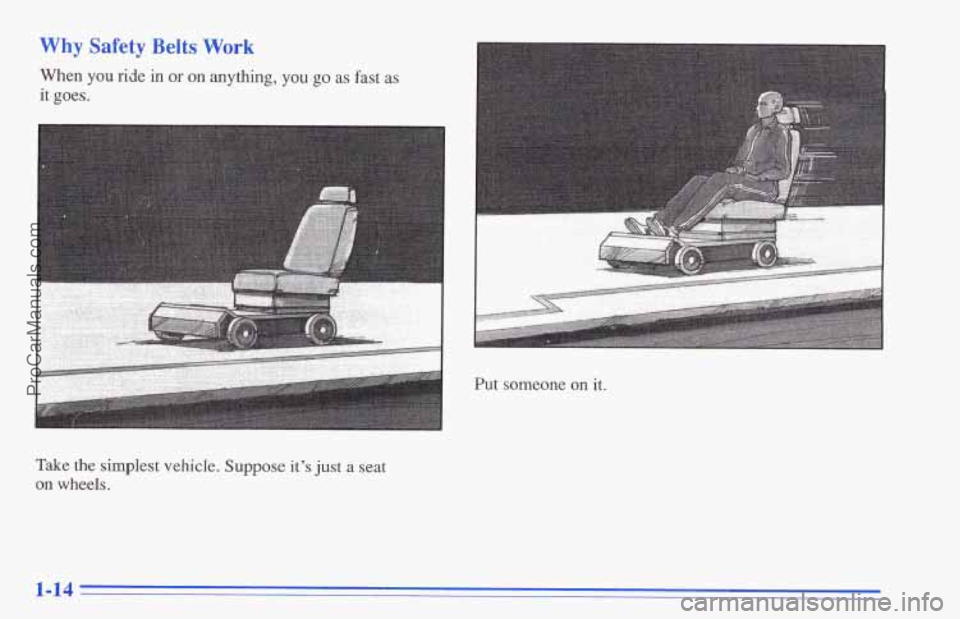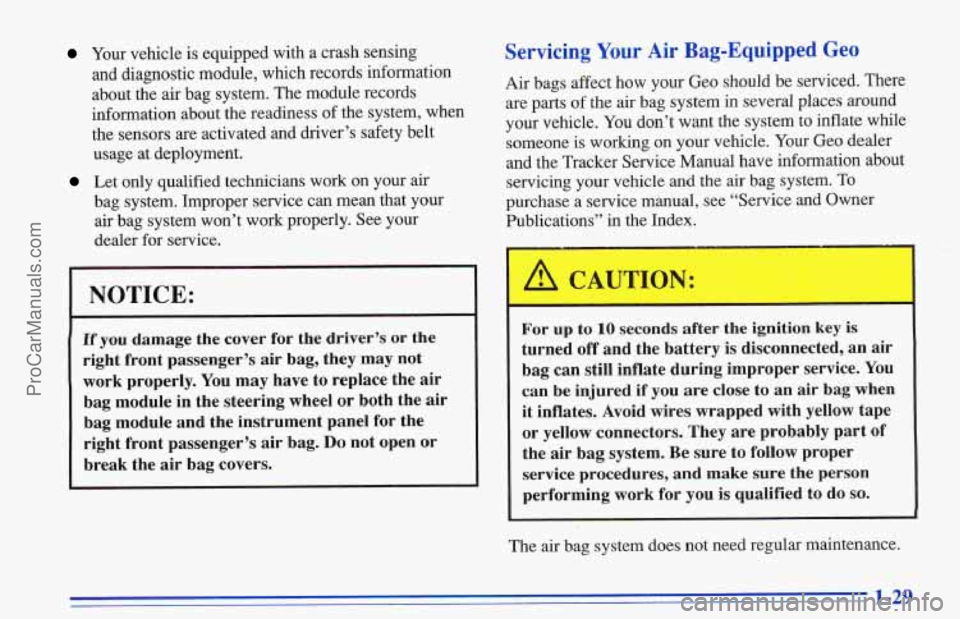1996 CHEVROLET TRACKER wheel
[x] Cancel search: wheelPage 4 of 387

4-DOOr Hardtop 2-Door Convertible
About Driving Your Geo
As with other vehicles of this type, failure to operate
, this vehicle correctly may result in loss of control or
an accident. Be sure to read the “on-pavement” and
“off-road” driving guidelines in this manual. (See
“Driving Guidelines”
and “Off-Road Driving with
your Four-Wheel-Drive Vehicle” in the Index.)
How to Use This Manual
Many people read their owner’s manual from beginning
to end when they first receive their new vehicle.
If you do
this, it will help
you learn about the features and controls
for your vehicle. In this manual, you’ll find that pictures
and words work together to explain things quickly.
Index ’
A good place to look for what you need is the Index in
the back
of the manual. It’s an alphabetical list of all
that’s in the manual, and the page number where
you’ll find it.
iii
ProCarManuals.com
Page 21 of 387

hy Safety
When you ride
it goes.
Belts WOI 1
in or on anything, you go as fast as
Take the simplest vehicle.
Suppose it’s just a seat
on wheels.
Put someone on it.
1-14
ProCarManuals.com
Page 33 of 387

How the Air Bag System Works
Where is the air bag?
The driver’s air bag is in the middle of the steering wheel.
P
’ The right front passenger’s air bag is in the instrument
panel
on the passenger’s side.
1-26
ProCarManuals.com
Page 34 of 387

Don’t put anything on, or attach anything to, the
steering wheel or instrument panel. Also, don’t
put anything (such as pets or objects) between
any occupant and the steering wheel or instrument panel. If something is between an
occupant and an air bag, it could affect the
performance of the air bag
-- or worse, it could
cause injury.
When
should an air bag inflate?
The air bag is designed to inflate in moderate to severe
frontal or near-frontal crashes. The air bag will inflate
only
if the impact speed is above the system’s designed
“threshold level.” If your vehicle goes straight into a
wall that doesn’t move or deform, the threshold level is
about
9 to 15 mph (14 to 24 km/h). The threshold level
can vary, however, with specific vehicle design,
so that
it can be somewhat above or below this range. If your
vehicle
strikes something that will move or deform, such
as a parked car, the threshold level
will be higher. The
air bag is not designed to inflate in rollovers, side
impacts or rear impacts, because inflation would not
help the occupant.
In any particular crash, no one can say whether
an air
bag should have inflated simply because of the damage
to a vehicle or because of what the repair costs were.
Inflation is determined by the angle of the impact and
the vehicle’s deceleration. Vehicle damage is only one
indication
of this.
The air bag system is designed to work properly under a
wide range
of conditions, including off-road usage.
Observe safe driving speeds, especially on rough terrain.
As always, wear your safety belt. See “Off-Road
Driving”
in the Index for more tips on off-road driving.
What makes an air bag inflate?
In a frontal or near-frontal impact of sufficient severity,
the air bag sensing system detects that the vehicle
is
suddenly stopping as a result of a crash. The sensing
system signals the inflator to produce a gas that inflates
the air
bags. The inflator, air bag and related hardware
are all part of the air bag modules packed inside the
steering wheel and in the instrument panel in front of the
right front passenger.
1-27
ProCarManuals.com
Page 35 of 387

How does an air bag restrain?
In moderate to severe frontal or near-frontal collisions,
even belted occupants can contact the steering wheel or
the instrument panel. The air bag supplements the
protection provided by safety belts.
Air bags distribute
the force
of the impact more evenly over the occupant’s
upper body, stopping the occupant more gradually. But
air bags would not help you in many types of collisions,
including rollovers, rear impacts and side impacts,
primarily because
an occupant’s motion is not toward the
air bag.
Air bags should never be regarded as anything
more than a supplement to safety belts, and then only in
moderate to severe frontal or near-frontal colli.sions.
What will you see after an air bag inflates?
After the air bag inflates, it quickly deflates. This occurs
so quickly that some people may not even realize the air
bag inflated. Some components
of the air bag module in
the steering wheel hub for the driver’s air bag,
or the
instrument panel for
the right front passenger’s bag, will
be hot for a short time. The part of the bag that comes
into contact with you may be warm, but it will never be
too hot
to touch. There will be some smoke and dust
coming
from vents in the deflated air bags. Air bag
inflation will not prevent the driver from seeing or from
being able to steer the vehicle, nor will it stop people
from leaving the vehicle.
When an air bag inflates, there is dust in the air.
This dust could cause breathing-problems for
people with a history
of asthma or other
breathing trouble.
To avoid this, everyone in the
vehicle should get
out as soon as it is safe to do so.
If you have breathing problems but can’t get out
of the vehicle after an air bag inflates, then get
fresh air by opening a window or door.
In many crashes severe enough to inflate ;in air bag,
windshields
are broken by vehicle deformation.
Additional windshield breakage
may also occur from the
right front passenger air
bag.
The air bags are designed to inflate only once. After
they inflate, you’ll need some new parts for your air
bag system.
If you don’t get them, the air bag system
won’t be there to help protect you
in ‘another crash.
A new system will include air bag modules and
possibly other
parts. The service manual for your
vehicle covers the need to replace other
parts.
1-28
ProCarManuals.com
Page 36 of 387

Your vehicle is equipped with a crash sensing
and diagnostic module, which records information
about the air bag system. The module records
information about the readiness
of the system, when
the sensors are activated and driver’s safety belt
usage at deployment.
bag system. Improper service can mean that your
air bag system won’t work properly. See your
dealer for service.
Let only qualified technicians work on your air
NOTICE:
If you damage the cover for the driver’s or the
right front passenger’s air bag, they may not
work properly.
You may have to replace the air
bag module in the steering wheel or both the air
bag module and the instrument panel for the
right front passenger’s air bag.
Do not open or
break the air bag covers.
Servicing Your Air Bag-Equipped Geo
Air bags affect how your Geo should be serviced. There
are parts
of the air bag system in several places around
your vehicle. You don’t want the system to inflate while
someone is working on your vehicle. Your Geo dealer
and the Tracker Service Manual have information about
servicing your vehicle and the air bag system.
To
purchase a service manual, see “Service and Owner
Publications” in the Index.
For up to 10 seconds after the ignition key is
turned off and the battery is disconnected, an air
bag can still inflate during improper service.
You
can be injured if you are close to an air bag when
it inflates. Avoid wires wrapped with yellow tape
or yellow connectors. They are probably part
of
the air bag system. Be sure to follow proper
service procedures, and make sure the person
performing work for you is qualified to do
so.
The air bag system does not need regular maintenance.
1-29
ProCarManuals.com
Page 61 of 387

Key in the Ignition
If you leave your vehicle with the keys inside, it’s an
easy target for joy riders or professional thieves -- so
don’t do it.
When you park your Geo and open the driver’s door,
you’ll hear a chime reminding you
to remove your key
from the ignition and take it with
you. Always do this.
Your steering wheel will
be locked, and so will your
ignition. If you have an automatic transmission, taking
your key out also locks your transmission. And
remember
to lock the doors.
Parking at Night
Park in a lighted spat, close all windows and lock your
vehicle. Remember to keep your valuables out of sight.
Put them in a storage area, or take them with you.
New Vehicle 46Break-InS’
I
NOTICE:
Your modern Geo doesn’t need an elaborate
“break-in.” But it will perform better in the long
run if you follow these guidelines:
Keep your speed at 55 mph (88 km/h) or
less for the first 500 miles (804 km).
Don’t drive at any one speed -- fast or
slow
-- for the first 500 miles (804 km).
Don’t make full-throttle starts,
200 miles (322 km) or so. During this time
your new brake linings aren’t
yet broken
in. Hard stops with new linings
can mean
premature wear and earlier replacement.
Follow this breaking-in guideline every
time
you get new brake linings.
See “Towing
a Trailer” in the Index for
more information.
0 Avoid making hard stops for the first
Don’t tow a trailer during break-in.
2-6
ProCarManuals.com
Page 62 of 387

Ignition Positions
4
With the key in the ignition
switch, you can
turn the
switch to four positions.,
LOCK (A): The only position in which you can remove
the key. This locks your steering wheel, ignition and
automatic transmission.
If you have an automatic transmission, the ignition
switch can’t be turned to LOCK unless the shift lever is
in the
PARK (P) position.
ACC (B): The position that you can operate your
electrical power accessories. It unlocks the steering
wheel and ignition. Use this position if your vehicle
must be pushed or towed.
ON (C): The position in which the switch returns to
after you start your engine and release the switch. The
switch stays in the
ON position when the engine is
running. But even when the engine is not running, you
can use ON to operate your electrical power accessories
and to display some instrument panel warning and
indicator lights.
START (D): The position in which the engine starts.
When the engine starts, release the key. The ignition
switch
will return to ON for normal driving.
When the engine is not running, ACC and
ON allow you
to operate your electrical accessories, such as the radio
and ventilation fan.
A warning chime will sound if you open the driver’s
door when the ignition is in ACC or LOCK and the key
is in the ignition.
2-7
ProCarManuals.com